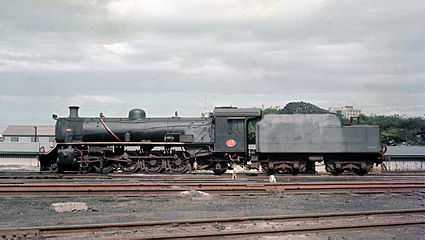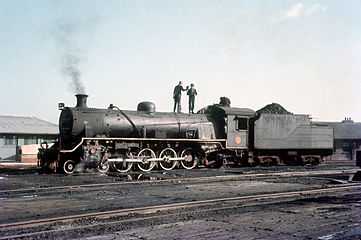South African Class 19A 4-8-2
| South African Class 19A 4-8-2 & South African Class 19AR 4-8-2 | |
|---|---|
|
Class 19A no. 685 at De Aar, 16 October 1978 | |
| Type and origin | |
| Power type | Steam |
| Designer | South African Railways |
| Builder | Swiss Locomotive and Machine Works |
| Serial number | 3300-3335 [1] |
| Model | Class 19A |
| Build date | 1929 |
| Total produced | 36 |
| Specifications | |
| Configuration | 4-8-2 "Mountain" |
| Gauge | 3 ft 6 in (1,067 mm) Cape gauge |
| Leading wheel diameter | 28.5 in (724 mm) |
| Driver diameter | 51 in (1,300 mm) |
| Trailing wheel diameter | 33 in (838 mm) |
| Wheelbase |
Total: 58 ft 7.625 in (17.872 m) Engine: 6 ft 2 in (1.880 m) bogie 14 ft 5 in (4.394 m) coupled 32 ft 2 in (9.804 m) total Tender: 4 ft 7 in (1.397 m) bogie 16 ft 8 in (5.080 m) total |
| Length | 67 ft 6 in (20.574 m) total |
| Height |
12 ft 10.875 in (3.934 m) as built 12 ft 11.875 in (3.959 m) reboilered |
| Frame | Bar frame |
| Axle load |
13.2 long tons (13.4 t) on 2nd driver as built 13.05 long tons (13.3 t) on 2nd driver reboilered |
| Weight on drivers |
51.35 long tons (52.2 t) as built 51.05 long tons (51.9 t) reboilered |
| Locomotive weight |
75.15 long tons (76.4 t) as built 76.1 long tons (77.3 t) reboilered |
| Tender weight |
51,020 lb (23.1 t) empty 50.95 long tons (51.8 t) w/o |
| Locomotive and tender combined weight |
147,810 lb (67.0 t) empty 127.05 long tons (129.1 t) w/o |
| Tender type |
MP - MP, MP1, MR, MX, MY, MY1 permitted * 2 axle bogies * Wheels 34 in (864 mm) dia * Length 25 ft 11.375 in (7.909 m) |
| Fuel type | Coal |
| Fuel capacity | 9.2 long tons (9.3 t) |
| Water capacity | 4,250 imp gal (19,300 l) |
| Boiler |
As built: 4 ft 10.25 in (1.480 m) inside diameter 20 ft 0.375 in (6.106 m) inside length 8 ft (2.438 m) pitch Reboilered: 5 ft (1.524 m) inside diameter 20 ft 2 in (6.147 m) inside length 8 ft 1 in (2.464 m) pitch |
| Boiler pressure | 200 psi (1,380 kPa) |
| Firegrate area | 36 sq ft (3.345 m2) |
| Heating surface: – Tubes |
As built: 86 tubes 2.25 in (57.1 mm) diameter 16 tubes 5.5 in (140 mm) diameter 1,627 sq ft (151.153 m2) Reboilered: 76 tubes 2.5 in (63.5 mm) diameter 24 tubes 5.5 in (140 mm) diameter 1,700 sq ft (157.935 m2) |
| – Flues |
15 sq ft (1.394 m2) as built 16 sq ft (1.486 m2) reboilered |
| – Firebox |
125 sq ft (11.613 m2) as built 123 sq ft (11.427 m2) reboilered |
| – Total |
1,667 sq ft (154.869 m2) as built 1,839 sq ft (170.849 m2) reboilered |
| Superheater area |
415 sq ft (38.555 m2) as built 404 sq ft (37.533 m2) reboilered |
| Cylinders | Two |
| Cylinder size |
19.5 in (495 mm) bore 26 in (660 mm) stroke |
| Valve gear | Walschaerts |
| Performance figures | |
| Tractive effort | 29,080 lbf (129 kN) at 75% pressure |
| Career | |
| Operator(s) | South African Railways [2] |
| Class | Class 19A, Class 19AR |
| Number in class | 36 |
| Number(s) | 675–710 |
| Delivered | 1929 |
| First run | 1929 |
| Withdrawn | 1966-1977 |
The South African Class 19A 4-8-2 of 1929 is a South African steam locomotive from the South African Railways era.
In 1929 the South African Railways placed thirty-six Class 19A steam locomotives with a 4-8-2 Mountain type wheel arrangement in service. Five of them were later reboilered and reclassified to Class 19AR.[2]
Manufacturer
The Class 19A 4-8-2 Mountain type steam locomotive was a later model of the successful Class 19 that was introduced a year earlier, also with Walschaerts valve gear and a bar frame. Colonel F.R. Collins, Chief Mechanical Engineer (CME) of the South African Railways (SAR) at the time, redesigned the Class 19 to achieve a lighter axle loading by reducing the wheel diameters from 54 to 51 inches (1,370 to 1,300 millimetres), reducing the cylinder diameter from 21 to 19.5 inches (533 to 495 millimetres) and by using a slightly smaller boiler.[1][3]
While the aim was to reduce the locomotive’s total weight for use on some of the more lightly laid branchlines, the actual weight saving that was achieved was a mere four tons, which could hardly have justified the cost of redesigning.[3]
Thirty-six Class 19A locomotives were delivered by Swiss Locomotive and Machine Works (SLM) of Winterthur in 1929, numbered in the range from 675 to 710.[3][4]
Watson Standard boilers
From the 1930s many serving locomotives were reboilered with a standard boiler type designed by then CME A.G. Watson as part of his standardisation policy. Such Watson Standard reboilered locomotives were reclassified by adding an "R" suffix to their classification.[2][4]
The South African Railways and Harbours Locomotive Diagram Book shows that five Class 19A locomotives, numbers 678, 693, 696, 700 and 706, were reboilered with Watson Standard no. 1A boilers and designated Class 19AR. In the reboilering process at least two of the Class 19AR locomotives, numbers 693 and 696, received domeless boilers from the first batch of Class 19D locomotives that were delivered new with domeless Watson Standard boilers.[2][3][4]
The reboilered Class 19AR locomotives gained less than a ton in weight during the modification process. While most locomotive classes that were reboilered with Watson Standard boilers were simultaneously equipped with Watson cabs with slanted fronts, some of the Class 19AR locomotives retained their original cabs with vertical fronts.[5]
On the reboilered Class 19AR there were, in fact, three versions of cab since no. 696 had a slanted cab from the running board up and the remains of the squared front cab from the running board down. Apart from the slanted front of the Watson cab, an obvious visual difference between an original and a Watson Standard reboilered locomotive is usually the rectangular object just to the rear of the chimney on the reboilered locomotive, the cover of the multiple valve regulator situated in the smokebox.
The number plate of no. 685, depicted alongside as it is displayed in the Outeniqua Transport Museum in George, is incorrectly inscribed "19AR" since that locomotive was retired without being reboilered with a Watson Standard boiler. The engine was photographed, still with its original boiler, as late as April 1970, fifteen years into electrification and dieselisation of the SAR and with steam traction already largely relegated to shunting and pickup work.
Similarly, the picture of the Class 19A rusting in peace at Queenstown, shown below with the number 693 hand-painted on the cabside, is actually of Class 19A no. 685. It has an as-delivered boiler while no. 693 was reboilered with a domeless Class 19D boiler. Both locomotives had been set aside by the Transnet Heritage Foundation for preservation, with no. 685 staged at Queenstown and no. 693 at Millsite in Krugersdorp, but each somehow had the other's number painted on their cabsides when their number plates were removed.[6]
Service
South African Railways
The Class 19A fleet initially served on all systems of the SAR, but were later based mainly at Mason’s Mill, Estcourt and Glencoe in Natal, at East London, Queenstown and Burgersdorp in the Eastern Cape, at Cape Town in the Western Cape and a few in the Western Transvaal.[3]
No. 700 was written off after an accident and by 1977 the rest were all withdrawn from Railways service. Numbers 685, 692 and 693 are known to still survive, no. 685 staged in the open at Queenstown in the Eastern Cape, no. 692 plinthed at Sterkstroom in the Eastern Cape and no. 693 staged at Millsite in Krugersdorp.[3][4][6][7]
Industrial
Several of these locomotives were sold into a second career in industrial service after being retired from SAR service.[3]
- Numbers 678 and 683 went to Tweefontein United Collieries. Number 678 later went to Witbank Consolidated Collieries.
- Number 679 went to Apex Mines at Greenside, later to the Fluor for Sasol plant and eventually to Dunn’s.
- Numbers 684 and 691 went to Gledhow Sugar Mill where they were named "Umvoti" and "Blythedale" respectively. Number 684 later went to Umgala Colliery.
- Numbers 689 and 707 went to Platberg Colliery.
- Number 710 went to Butakon Limited, then to Southern Cross Steel Company in Middelburg, Transvaal, and eventually to Umgala Colliery at Utrecht in Natal.
Service illustrated
The main picture shows Class 19A no. 685 at De Aar on 16 October 1978, at the time recently retired and earmarked for preservation. The same locomotive is shown below as well, staged in the open at Queenstown in the Eastern Cape and with sundry parts missing, incorrectly marked as no. 693.
-
.jpg)
A Class 19A locomotive shortly after entering service, at Paardeneiland in Cape Town, circa 1930
-

Class 19A no. 685 at the East London Locoshed in Cambridge, still with its original boiler, 16 April 1970
-
.jpg)
Class 19A no. 685 at Queenstown, 26 April 2013, incorrectly marked as reboilered Class 19AR no. 693
-

Class 19A no. 705 at the East London Locoshed in Cambridge, 16 April 1970
-

Class 19AR no. 693, reboilered with a domeless Watson Standard boiler from a first-batch Class 19D, Queenstown c. 1969
See also
- List of South African locomotive classes
- South African Class 19 4-8-2
- South African Class 19B 4-8-2
- South African Class 19C 4-8-2
- South African Class 19D 4-8-2
- South African locomotive history
- Tender locomotive numbering and classification
- The 4-8-2 "Mountain"
- Watson Standard boilers
References
|
- ↑ 1.0 1.1 Holland, D.F. (1972). Steam Locomotives of the South African Railways, Volume 2: 1910-1955 (1st ed.). Newton Abbott, Devon: David & Charles. pp. 62–63. ISBN 978-0-7153-5427-8.
- ↑ 2.0 2.1 2.2 2.3 South African Railways and Harbours Locomotive Diagram Book, 2’0” & 3’6” Gauge Steam Locomotives, 15 August 1941, pp21 & 21A, as amended
- ↑ 3.0 3.1 3.2 3.3 3.4 3.5 3.6 Durrant, A E (1989). Twilight of South African Steam (1st ed.). Newton Abbott, London: David & Charles. p. 99. ISBN 0715386387.
- ↑ 4.0 4.1 4.2 4.3 Paxton, Leith; Bourne, David (1985). Locomotives of the South African Railways (1st ed.). Cape Town: Struik. pp. 10–11, 70. ISBN 0869772112.
- ↑ Dulez, Jean A. (2012). Railways of Southern Africa 150 Years (Commemorating One Hundred and Fifty Years of Railways on the Sub-Continent - Complete Motive Power Classifications and Famous Trains - 1860-2011) (1st ed.). Garden View, Johannesburg, South Africa: Vidrail Productions. pp. 140–141. ISBN 9 780620 512282.
- ↑ 6.0 6.1 Final SAHRA List, p. 18, Category C Locomotives (For Disposal): Class 19A/19AR
- ↑ Sterkstroom, Municipality - SAR Class 19A No 692
.jpg)